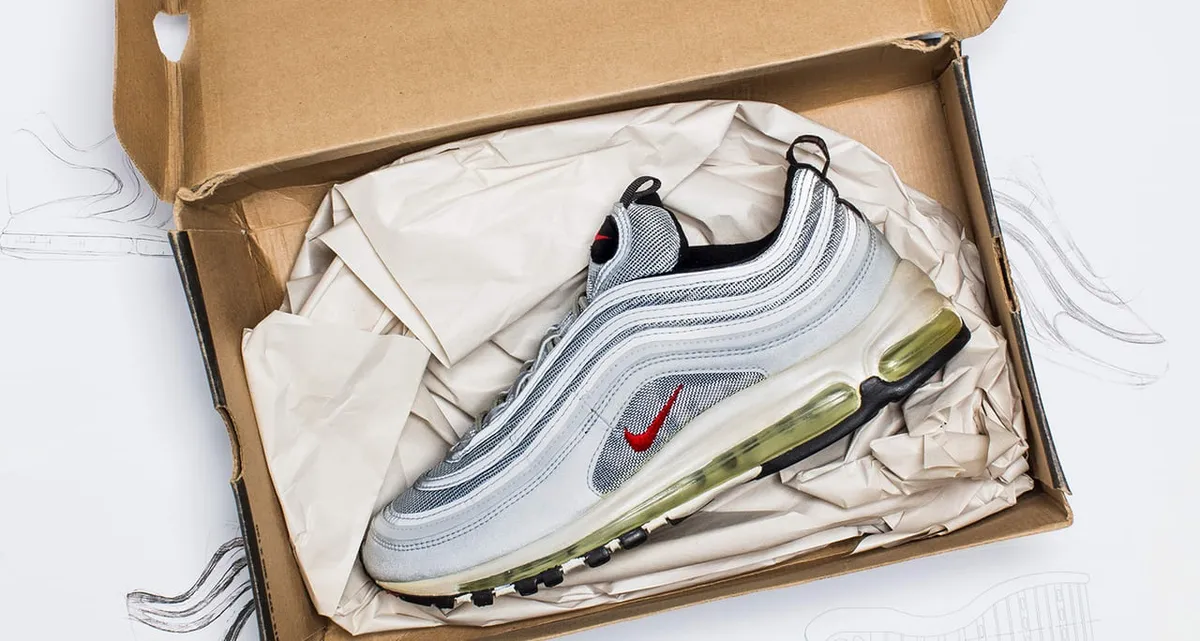Picture a sneaker that dropped in 1997 with the promise of shaking up everything Nike had ever done. Now imagine that, nearly 30 years later, it’s still out there on the streets, on the feet of sneakerheads, and in limited-edition drops that sell out in minutes. That’s the Nike Air Max 97—a classic that blends cutting-edge tech, bold design, and a story with layers. It’s not just a shoe; it’s a piece of ‘90s culture that’s still kicking, like a fine wine that just gets better with age. Wanna know how it came to be and why it’s still making waves? Buckle up for the ride!
From the first sketch to legendary status, the Air Max 97 has a lot to say. Let’s dive into who created it, the vibe of the era, the game-changing tech, and, of course, the real inspiration behind those wavy lines everyone loves. Spoiler: it’s got something to do with nature, but it’s not what you might think. We’ll break it down step by step, so you can see exactly how this icon came to life.
The ‘90s Vibe and the Air Max Line
To get the Air Max 97, we gotta rewind to the ‘90s, when Nike was ruling the sneaker world. It all kicked off in 1987 when Tinker Hatfield dropped the Air Max 1 and blew minds with a visible air cushion in the sole. It was a game-changer: suddenly, cushioning wasn’t just functional—it was part of the style. Models like the Air Max 90 and Air Max 95 followed, each pushing the boundaries of design and tech a little further.
By 1995, the Air Max 95, with its Grand Canyon-inspired layers, had set the bar sky-high. Two years later, Nike needed something fresh to keep the hype alive and prove the Air Max line still had juice. That’s when the Air Max 97 started taking shape. But before it hit the shelves, it needed a creator who could handle the challenge. Enter Christian Tresser.
Who’s Christian Tresser?
Christian Tresser wasn’t some rookie when he took on the Air Max 97 project. A Nike designer in the ‘90s, he had experience with athletic footwear and a sharp eye for detail. Two other designers had tried and failed to crack the new Air Max concept before it landed in Tresser’s lap. The pressure was on: either he delivered something revolutionary, or the sneaker risked becoming just another forgotten sketch in Nike’s archives.
Tresser didn’t flinch. He started from scratch with a clear vision: create a sneaker that went beyond function and defined an era. He brought his love for mountain bikes and a unique way of seeing the world to the table. The main inspiration for the design? We’ll get to that in a bit—it deserves its own moment. For now, know that Tresser was ready to make history.
The Tech That Changed the Game
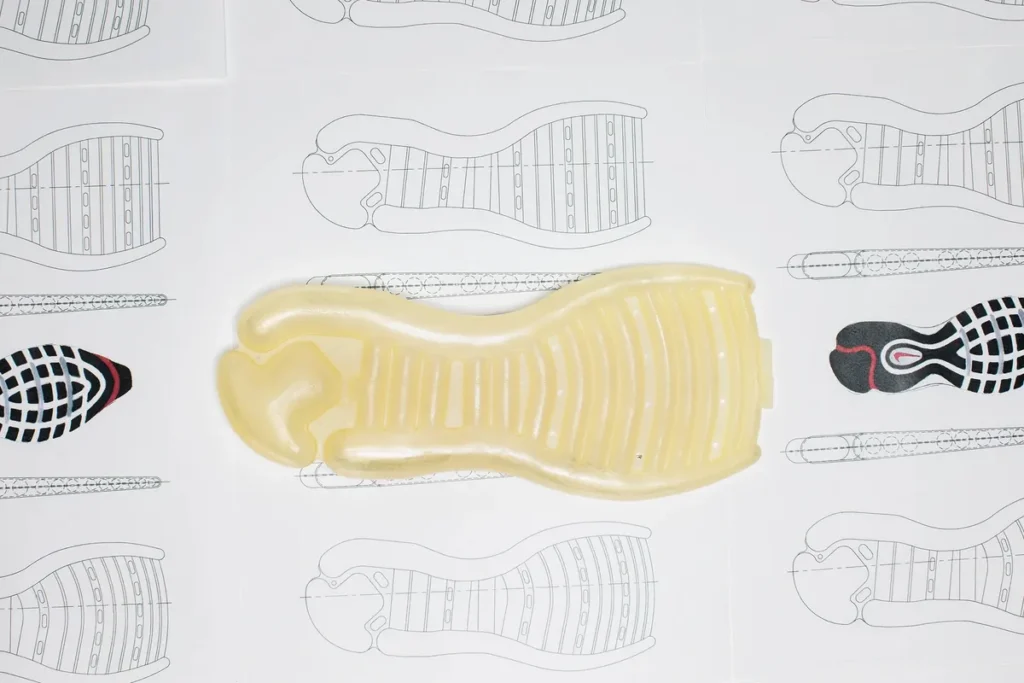
The Air Max 97 wouldn’t be what it is without its big breakthrough: the first full-length visible Air unit, stretching from heel to toe. Before it, Air Max models had air cushions in specific spots, like the heel or forefoot. The 97 flipped the script, extending the air bubble across the entire midsole. The result? A feeling of lightness and comfort that was out of this world.
Behind this feat was some serious work from Nike’s development team. Balancing air pressure and the shape of the cushion to ensure stability across the whole foot wasn’t easy. But when they nailed it, they created a sneaker that was both functional for runners and stylish for the streets. The transparent sole, showing off the Air tech like a display case, only amplified the impact. It was like Nike was saying, “Check out what we can do.”
The Launch and Initial Impact
In 1997, the Nike Air Max 97 hit stores with the “Silver Bullet” as the star of the show. Its metallic silver finish, paired with 3M reflective details, made it an instant hit. In Italy, it became a craze among the “paninari” subculture, who loved its flashy look. In Japan, it won over streetwear fans. And in the U.S., rappers and artists started rocking it, taking the sneaker beyond sports and straight into urban culture.
The price, higher than other models at the time, sparked some complaints. But the hype was louder. Limited editions sold out fast, and the Air Max 97 quickly became a status symbol. Its fluid lines and futuristic shine fit perfectly with the experimental, bold vibe of the late ‘90s.
The Real Inspiration: Water Ripples, Not Bullet Trains
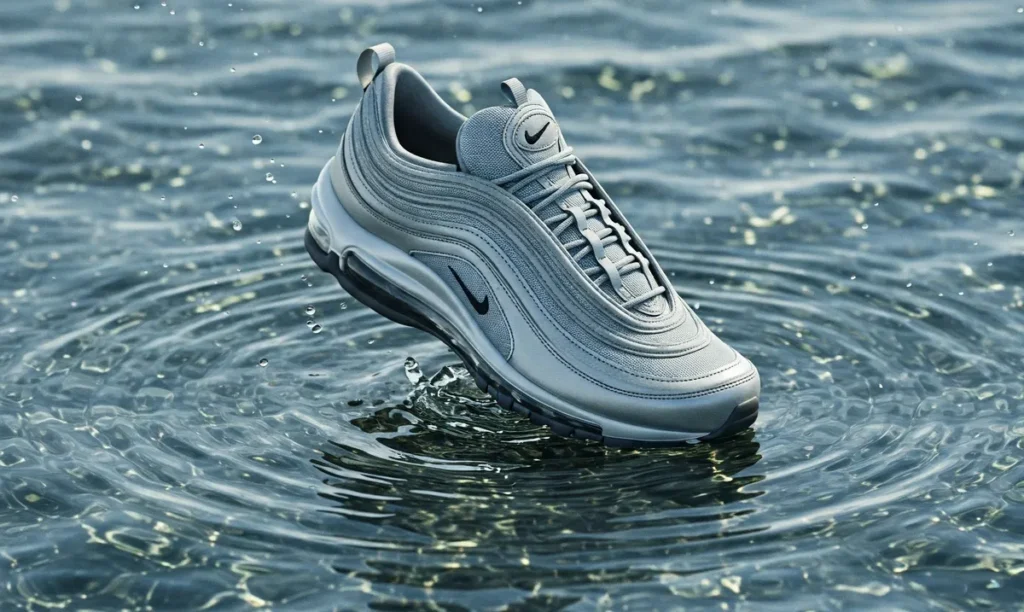
Now we get to the heart of the story: where did the Air Max 97’s design come from? If you’ve heard it was inspired by Japanese bullet trains speeding at 185 mph, you might’ve thought that was a dope idea. The “Silver Bullet” finish and wavy lines do scream speed and modernity. But here’s the truth: that’s a myth. Christian Tresser has debunked it in interviews, and the real inspiration is way more poetic.
According to Tresser, the Air Max 97 was born from a simple moment: watching water droplets hit a surface and create ripples. Those smooth, organic waves became the iconic lines running across the sneaker’s upper. “I wanted something that conveyed movement, but in a natural, not mechanical, way,” he said in an interview with Sneaker Freaker. Check out more details straight from the source.
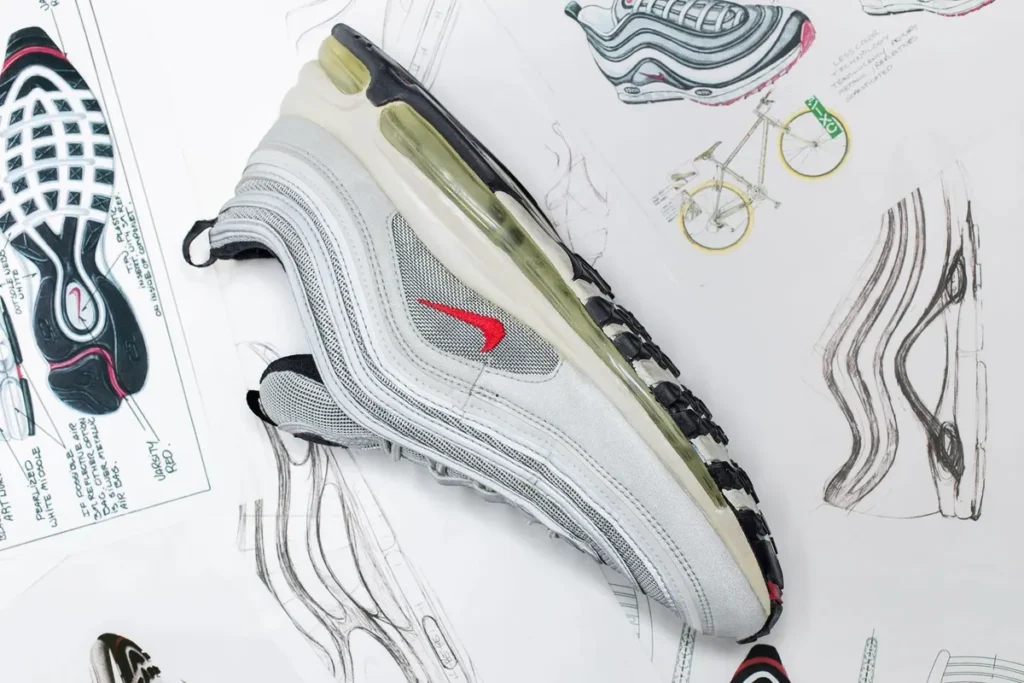
And the silver tone? That came from Tresser’s love for mountain bikes. He was obsessed with the metallic gleam of their frames and brought that aesthetic to the sneaker. So, forget bullet trains: the “Silver Bullet” is a mix of water ripples and bikes, with a dash of genius.
Why the Air Max 97 Still Kills It
Nearly three decades later, the Air Max 97 is still going strong. Its timeless design, with those wavy lines and metallic shine, still feels fresh. But that’s not all. Nike keeps the model alive with killer collabs, like the 2017 Undefeated drop and special editions with Cristiano Ronaldo. Every re-release brings something new while staying true to the original vibe.
Its versatility helps, too. The Air Max 97 pairs with jeans, cargo pants, or even a dressed-up look, moving between casual and stylish like few others. And the sneakerhead community keeps the hype alive: rare pairs fetch crazy prices on platforms like StockX, proving it’s still a must-have.
Top Air Max 97 Collabs
The Air Max 97 is that sneaker you spot from a mile away with its wavy lines. Since its 1997 debut, it’s been a perfect canvas for some dope collabs. Here are some of the most iconic ones I’ve seen:
- Nike x Off-White (2017)
The Off-White “The Ten” collab with Nike is one of the most legendary in sneaker history. Launched in 2017, it was masterminded by Virgil Abloh, the genius behind Off-White, who took ten classic Nike silhouettes and reimagined them with his signature deconstructed style. - Nike x Undefeated (2017)
This collab is a streetwear classic. Undefeated brought a straight-up LA vibe to the 97, with colors like black, red, and green, plus that “UNDFTD” logo for extra clout. I remember sneakerheads losing it trying to cop a pair—the design was aggressive yet slick, like the sneaker you wear to show you’re in the know. - Nike x Skepta (2017)
British rapper Skepta gave the Air Max 97 a fresh spin, mixing earthy tones with iridescent details. Drawing from his Moroccan roots and London’s street vibe, the result was a sneaker that screams “one of a kind.” To me, this collab is a perfect example of how music and fashion can collide in a sneaker. - Nike x Sean Wotherspoon (2017)
If there’s a collab that made waves, it’s this one. Sean Wotherspoon, a hype king, blended the Air Max 97 with the Air Max 1, creating the iconic “1/97.” With colorful corduroy and a retro vibe, it became an instant grail. I’ve seen people camping online to snag a pair—and they weren’t cheap! It’s a sneaker culture milestone. - Nike x Megan Thee Stallion (2024)
More recent, this collab with rapper Megan Thee Stallion brought an Air Max 97 packed with attitude. Nike dropped models with vibrant colors and details that scream her “Hot Girl Summer” style. I love how they made the 97 even bolder—perfect for anyone looking to make an entrance. - Nike x Cristiano Ronaldo (2017)
Rounding it out, the CR7 collab honored the soccer star’s childhood in Portugal with gold details and a design that screams luxury and victory. I dig how it blends sport with sophistication—like the sneaker you wear to say, “I’m a champ.”
These collabs show how versatile the Air Max 97 is. It’s been everything from pure streetwear to a cultural tribute to a flex of status. But it’s not all smooth sailing—let’s talk controversies!
Biggest Air Max 97 Controversies
The Air Max 97 has been through some drama that left fans shook. Here are the biggest controversies I’ve followed:
- Lil Nas X and the “Satan Shoes” (2021)
This one was wild! The MSCHF collective customized the Air Max 97 with a satanic theme—pentagrams, red ink, and even a drop of human blood in the sole (yep, you read that right). Dubbed “Satan Shoes” and tied to Lil Nas X, Nike was furious and filed a lawsuit to halt sales. A U.S. judge shut it down. Fans were split: some called it genius, others disrespectful. It’s a controversial milestone in the sneaker’s history. - Knockoff and Counterfeit Accusations
The Air Max 97 is so iconic that the fake market’s always trying to cash in. This has sparked plenty of drama, with Nike fighting to protect the original design. I’ve seen sneakerheads go off about spotting fakes—down to the box quality and serial numbers. It’s a never-ending saga! - Skyrocketing Resale Prices
Some collabs, like Sean Wotherspoon’s, have shot up in price on the resale market. What retailed for $160 can now go for over $1,000! This stirred up complaints among fans, who feel the hype makes the 97 unattainable. I get it—it’s frustrating when a sneaker you love turns into a luxury item. - Comfort Complaints
Despite the Air Max tech, some folks say the 97 isn’t as comfy as other models like the 95 or 270. This sparked heated debates in the sneaker community, with some prioritizingබැටමින් 3600 prioritizing design over everything and others demanding more function. I think it depends on the foot, but the convo’s intense! - Hydrolysis
Hydrolysis is a common issue with the Air Max 97, especially in the midsole’s air units. Over time, moisture and heat can break down the polyurethane, causing cracks or even collapsing the air chamber. This messes with both cushioning and aesthetics, bumming out fans. Proper care and dry storage can help prevent it.
Conclusion: A Classic That Keeps Rippling
For sneaker lovers, the Nike Air Max 97 is more than a shoe—it’s a piece of history. Christian Tresser took the simplicity of water ripples and turned it into an icon that’s spanned generations. The bullet train myth is a cool story, but the truth about ripples is what gives it soul. And that full-length Air tech? That’s what made it a legend.
Looking back and forward, the Air Max 97 proves a great sneaker can be timeless. It keeps inspiring, captivating, and showing that sometimes the best ideas come from the simplest things. Next time you lace up a pair, remember: you’re walking on ripples, not train tracks.
FAQ
Who created the Nike Air Max 97?
Nike designer Christian Tresser created the sneaker in 1997.
What was the Air Max 97’s big innovation?
It introduced the first full-length visible Air unit from heel to toe.
What inspired the Air Max 97’s design?
Christian Tresser was inspired by water droplets creating ripples.
Was the Air Max 97 inspired by Japanese bullet trains?
No, that’s a popular myth. The design came from water ripples.
When was the Nike Air Max 97 released?
It hit stores in 1997, with “Silver Bullet” as the original colorway.
Why’s the Air Max 97 called “Silver Bullet”?
The nickname comes from its metallic silver finish, inspired by mountain bikes.
Is the Air Max 97 comfy for daily wear?
Yeah, the Air tech provides lightweight, lasting cushioning for casual use.
What’s the most famous Air Max 97 colorway?
The “Silver Bullet” with its metallic silver vibe is the most iconic.
Is the Air Max 97 still popular today?
Absolutely, it’s still re-released and loved by sneakerheads and streetwear fans.
Where can I buy an authentic Air Max 97?
Official Nike stores or trusted platforms like StockX are solid bets.
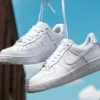 Nike Air Force One: The Iconic Sneaker’s History & Impact
Nike Air Force One: The Iconic Sneaker’s History & Impact Nike x Off-White: The Collaboration That Revolutionized Sneakers and Fashion
Nike x Off-White: The Collaboration That Revolutionized Sneakers and Fashion Air Jordan 1 – The Story of the Sneaker that Defied the Rules and Became Legend
Air Jordan 1 – The Story of the Sneaker that Defied the Rules and Became Legend What is Nike Air? Learn more about one of Nike’s Best Technologies
What is Nike Air? Learn more about one of Nike’s Best Technologies Top 10 Futuristic Nike Sneakers: Innovative Design and Cutting-Edge Technology
Top 10 Futuristic Nike Sneakers: Innovative Design and Cutting-Edge Technology The Journey of the Nike Dunk: A Timeless Story of Courts, Streets, and Culture
The Journey of the Nike Dunk: A Timeless Story of Courts, Streets, and Culture